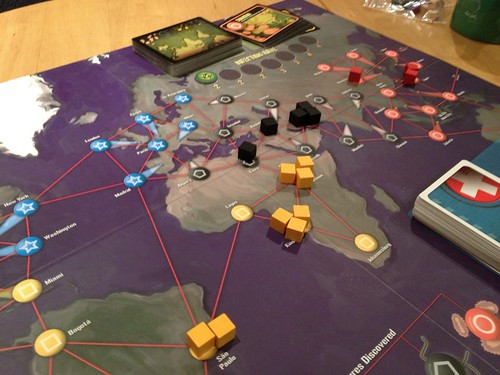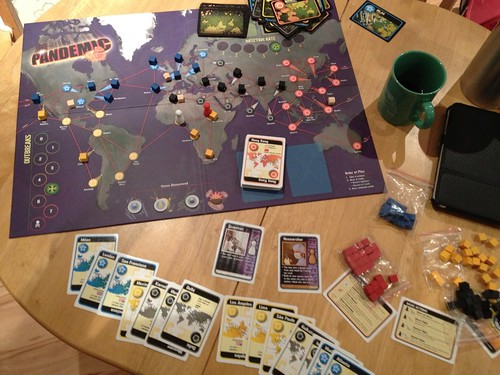 |
| Set up |
I picked up a copy of the boardgame Pandemic at Furnace and as I had a quiet night with Jill out and the boys asleep, I decided to give it a quick go to see how it works.
The premise of the game is quite simple; the world is suffering from a pandemic event with four diseases potentially running wild. Each player represents an agency or researcher with special skills that can help defeat the outbreaks of disease. The game can handle 2-4 players and lasts around an hour.
The components are of good quality, with a nice solid board and wooden pieces. The cards seem durable with a linen effect that gives good grip.
 |
| Infection zones |
I tried a two player game on the lowest difficulty level and was thoroughly trounced! It started well, with no outbreaks in Europe, and a small outbreak in South East Asia. Africa was the worst area , with some threats looming in the Middle East. The disease outbreaks are represented by wooden blocks of different colours, and each location can have a maximum of three of each type. At the start of the game, three cities have 3 blocks, three have 2 blocks and (you guessed it) three have 1 block.These are determined by the draw of infection cards, which are then placed on the discard pile. Each card shows a city and a disease colour, determining where the next infection is. If you run out of infection blocks to play for a colour at any time the players then lose.
The mechanics are joyously simple. Each city is connected to the others in a web that dictates travel and the spread of disease. Every turn you take 4 actions, which can range from travel through to passing cards to other players, building research centres, finding the cure and healing disease. If you have a cure, you can wipe out a disease completely at a location, otherwise you can reduce it by one block.
After taking actions, you draw two more player cards. These show cities and related disease colours. You need a research station of 5 cards of the right disease colour to find a cure, unless you're the scientist role, in which case it's only 4 cards. There are also special event cards (for example money to build a research station for free) and epidemic cards. Epidemic cards are nasty. They are dealt into the player card pile with between 4 and 6 in play depending on the challenge level you want. I played the introductory version with four cards. If you draw one, the rate of infection cards you draw each turn can increase (see next bit) and a city gets infected to the point of outbreak (ditto) which is really quite nasty. Finally, all the discarded infection cards (i.e. cities that are already infected) get reshuffled and placed on the top of the infection draw pile so you can be infected in the same points again, raising the intensity of the game. The only respite is if you have eradicated a disease completely, in which case no new disease blocks can be played. If you run out of player cards, you lose as well.
The infection stage is quite nasty. You draw a number of infection cards which show the cities that gain a single extra block. Unless they already have three blocks of the same colour in which case the disease 'outbreaks' and all adjacent cities gain a block of the disease. This can result in a cascading chain reaction, which is only limited by the fact that each city can only be infected once. If you have eight outbreaks, you lose.
 |
| End Game |
I quickly found the cure for the South East Asian outbreak, and for Europe, but Africa and the Middle East were proving more elusive. You very quickly get a feeling of quiet desperation as, even with the cure, you can only normally cure two adjacent cities per turn with the action limit. If you get a few adjacent cities with 3 blocks the same colour it feels really, really bad. It also feels great when you draw an infection card for a disease you've eradicated, so nothing happens.
I had beaten the European plague back, and done enough to slow the Middle Eastern Outbreaks, and was focussed with both players on eradicating the African and South American infection (maybe the hardest?) when I ran out of player cards, thinking I'd lost. It was only as I was packing away - thinking how hard, but how addictive the game was - that I realised that I'd actually won by finding all four cures.
I really like this game, and look forward to playing it with friends. I can imagine that it could be a little frustrating and hard, but it gives quite a buzz!
No comments:
Post a Comment